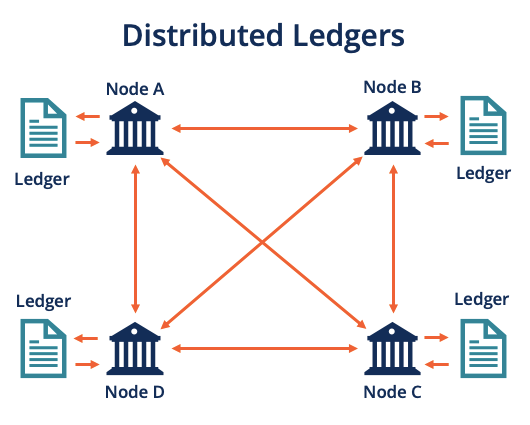1. Introduction & Overview
What is a Distributed Ledger?

A Distributed Ledger (DL) is a database spread across multiple nodes, regions, or institutions. Unlike a traditional centralized ledger maintained by a single authority, every participant in a distributed ledger network maintains a synchronized copy. Updates occur via consensus rather than unilateral control, making the system transparent, secure, and tamper-resistant.
History & Background
- Double-entry accounting (1400s): The origin of modern ledgers.
- Digital ledgers (1960s–2000s): Banks and enterprises maintained centralized electronic records.
- Bitcoin (2008/2009): Introduced the first practical distributed ledger via blockchain.
- Modern evolution: From cryptocurrency to enterprise DLTs (Distributed Ledger Technologies) such as Hyperledger, Corda, and Quorum.
Why Relevant in Cryptoblockcoins?
- Ensures trust without intermediaries.
- Provides immutable records of transactions.
- Supports peer-to-peer value exchange at scale.
- Backbone for smart contracts, tokenization, and DeFi applications.
2. Core Concepts & Terminology
Key Terms
- Node: A participant maintaining a ledger copy.
- Consensus Mechanism: The protocol by which nodes agree (e.g., Proof of Work, Proof of Stake).
- Smart Contract: Self-executing code embedded in the ledger.
- Immutability: Once recorded, data cannot be altered.
- DLT vs Blockchain: Blockchain is one type of distributed ledger; not all DLTs require blocks.
Role in Cryptoblockcoins Lifecycle
| Phase | Role of Distributed Ledger |
|---|---|
| Coin Creation | Records genesis blocks and token supply. |
| Transaction Validation | Ensures transfers are verified by consensus. |
| Ownership Tracking | Maintains transparent, immutable balances. |
| Smart Contracts | Automates logic like staking, lending, or swaps. |
| Auditing | Provides full traceability of all movements. |
3. Architecture & How It Works
Components
- Ledger: The data structure storing records (blockchain or DAG).
- Consensus Engine: Validates transactions.
- Networking Layer: Facilitates peer-to-peer communication.
- API/Smart Contract Layer: Exposes programmable logic.
- Storage Layer: Local and distributed storage across nodes.
Internal Workflow
- A user submits a transaction.
- Nodes broadcast the transaction across the network.
- The consensus mechanism validates authenticity.
- Transaction is appended to the ledger.
- Updated state is propagated to all nodes.
Architecture Diagram (textual description)
+------------------------------------------------+
| Application Layer |
| (Wallets, Exchanges, dApps, Smart Contracts) |
+------------------------------------------------+
| API & Contract Layer |
| (DLT APIs, SDKs, Oracles, Integrations) |
+------------------------------------------------+
| Consensus Layer |
| (PoW, PoS, BFT, RAFT depending on DLT type) |
+------------------------------------------------+
| Networking Layer |
| (P2P Protocols, Gossip, Node Communication) |
+------------------------------------------------+
| Data & Ledger Layer |
| (Blockchain, DAG, State DB, Cryptography) |
+------------------------------------------------+
| Infrastructure Layer |
| (Nodes, CI/CD Pipelines, Cloud Deployment) |
+------------------------------------------------+
Integration with CI/CD & Cloud
- Smart contracts deployed through CI/CD pipelines (Jenkins, GitHub Actions).
- Containers (Docker, Kubernetes) for scalable node management.
- Monitoring & logging tools (Prometheus, Grafana) for health tracking.
4. Installation & Getting Started
Prerequisites
- OS: Linux/Ubuntu recommended.
- Tools: Docker, Git, Node.js.
- Knowledge: Basic CLI and GitHub.
Hands-On: Quickstart with Hyperledger Fabric (example)
# Install prerequisites
sudo apt-get update
sudo apt-get install docker docker-compose git -y
# Clone Fabric samples
git clone https://github.com/hyperledger/fabric-samples.git
cd fabric-samples/test-network
# Start the test network
./network.sh up createChannel -c mychannel -ca
# Deploy chaincode (smart contract)
./network.sh deployCC -ccn basic -ccp ../asset-transfer-basic/chaincode-go -ccl go
Check logs to confirm the network and contracts are running.
5. Real-World Use Cases
Cryptoblockcoins Scenarios
- Token Transfers: Peer-to-peer coin transactions validated on a public ledger.
- Smart Contracts for DeFi: Lending/borrowing protocols like Aave or Compound.
- NFT Minting: Asset uniqueness tracked immutably.
- Cross-Border Payments: Near-instant settlements without banking intermediaries.
Industry-Specific Examples
- Finance: JPMorgan’s Onyx platform for interbank settlement.
- Supply Chain: IBM Food Trust tracking food provenance.
- Healthcare: Secure patient record management.
6. Benefits & Limitations
Key Advantages
- Transparency and immutability.
- Eliminates intermediaries.
- Scalability with DAG-based ledgers.
- High fault tolerance.
Limitations
- Energy-intensive (PoW).
- Latency in transaction finality.
- Regulatory uncertainty.
- Complex governance models.
7. Best Practices & Recommendations
- Security: Use multi-signature wallets, regularly audit smart contracts.
- Performance: Optimize node placement and caching.
- Maintenance: Apply version control for smart contracts.
- Compliance: Follow GDPR/financial KYC norms.
- Automation: Use CI/CD pipelines for contract updates.
8. Comparison with Alternatives
| Feature | Distributed Ledger | Centralized Database | Traditional Ledger |
|---|---|---|---|
| Authority | Decentralized | Centralized | Centralized |
| Transparency | High | Limited | Limited |
| Immutability | Yes | No | No |
| Performance | Medium (depends on consensus) | High | High |
| Security | Strong (crypto-based) | Vulnerable to single point of failure | Vulnerable to tampering |
| Use Case | Cryptoblockcoins, DeFi, NFTs | Enterprise apps | Accounting |
When to choose DL over others:
- When trustless collaboration is required.
- When auditability and immutability are non-negotiable.
- When global peer-to-peer systems are needed.
9. Conclusion
Distributed Ledgers are the backbone of cryptoblockcoins, redefining trust, transparency, and decentralization in digital finance. While they bring complexity and regulatory questions, their potential across industries is transformative.
Future Trends:
- Energy-efficient consensus (Proof of Stake, Proof of Authority).
- Interoperability protocols bridging multiple blockchains.
- Integration with AI for fraud detection and optimization.
Next Steps:
- Explore open-source projects like Hyperledger, Corda, or Quorum.
- Experiment with private test networks.
- Join communities like Hyperledger Foundation or Ethereum Foundation.